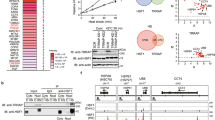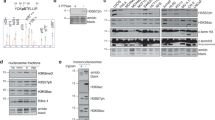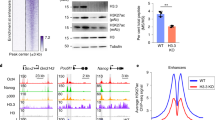Abstract
Phosphorylation of linker histone H1S-3 (previously named H1b) and core histone H3 is elevated in mouse fibroblasts transformed with oncogenes or constitutively active mitogen-activated protein kinase (MAPK) kinase (MEK). H1S-3 phosphorylation is the only histone modification known to be dependent upon transcription and replication. Our results show that the increased amounts of phosphorylated H1S-3 in the oncogene Ha-ras-transformed mouse fibroblasts was a consequence of an elevated Cdk2 activity rather than the reduced activity of a H1 phosphatase, which our studies suggest is PP1. Induction of oncogenic ras expression results in an increase in H1S-3 and H3 phosphorylation. However, in contrast to the phosphorylation of H3, which occurred immediately following the onset of Ras expression, there was a lag of several hours before H1S-3 phosphorylation levels increased. We found that there was a transient increase in the levels of p21cip1, which inhibited the H1 kinase activity of Cdk2. Cdk2 activity and H1S-3 phosphorylated levels increased after p21cip1 levels declined. Our studies suggest that persistent activation of the Ras-MAPK signal transduction pathway in oncogene-transformed cells results in deregulated activity of kinases phosphorylating H3 and H1S-3 associated with transcribed genes. The chromatin remodelling actions of these modified histones may result in aberrant gene expression.
This is a preview of subscription content, access via your institution
Access options
Subscribe to this journal
Receive 50 print issues and online access
$259.00 per year
only $5.18 per issue
Buy this article
- Purchase on Springer Link
- Instant access to full article PDF
Prices may be subject to local taxes which are calculated during checkout






Similar content being viewed by others
References
Bottazzi ME, Zhu X, Bohmer RM, Assoian RK . 1999 J. Cell Biol. 146: 1255–1264
Chadee DN, Allis CD, Wright JA, Davie JR . 1997 J. Biol. Chem. 272: 8113–8116
Chadee DN, Hendzel MJ, Tylipski CP, Allis CD, Bazett-Jones DP, Wright JA, Davie JR . 1999 J. Biol. Chem. 274: 24914–24920
Chadee DN, Taylor WR, Hurta RAR, Allis CD, Wright JA, Davie JR . 1995 J. Biol. Chem. 270: 20098–20105
Crissman HA, Gadbois DM, Tobey RA, Bradbury EM . 1991 Proc. Natl. Acad. Sci. USA 88: 7580–7584
Egan SE, McClarty GA, Jarolim L, Wright JA, Spiro I, Hager G, Greenberg AH . 1987 Mol. Cell Biol. 7: 830–837
Gadbois DM, Crissman HA, Tobey RA, Bradbury EM . 1992a Proc. Natl. Acad. Sci. USA 89: 8626–8630
Gadbois DM, Hamaguchi JR, Swank RA, Bradbury EM . 1992b Biochem. Biophys. Res. Commun. 184: 80–85
Haliotis T, Trimble W, Chow S, Bull S, Mills G, Girard P, Kuo JF, Hozumi N . 1990 Int. J. Cancer 45: 1177–1183
Herrera RE, Chen F, Weinberg RA . 1996 Proc. Natl. Acad. Sci. USA 93: 11510–11515
Kivinen L, Tsubari M, Haapajarvi T, Datto MB, Wang XF, Laiho M . 1999 Oncogene 18: 6252–6261
Kraemer PM, Bradbury EM . 1993 Exp. Cell Res. 207: 206–210
Laitinen J, Sistonen L, Alitalo K, Holtta E . 1990 J. Cell. Biol. 111: 9–17
Laitinen J, Sistonen L, Alitalo K, Holtta E . 1994 J. Cell Biochem. 57: 1–11
Lee HL, Archer TK . 1998 EMBO J. 17: 1454–1466
Lennox RW, Oshima RG, Cohen LH . 1982 J. Biol. Chem. 257: 5183–5189
Lu MJ, Dadd CA, Mizzen CA, Perry CA, McLachlan DR, Annunziato AT, Allis CD . 1994 Chromosoma 103: 111–121
Mahadevan LC, Willis AC, Barratt MJ . 1991 Cell 65: 775–783
Mello MLS, Chambers AF . 1994 Anal. Quant. Cytol. Histol. 16: 2 113–123
Parseghian MH, Hamkalo BA . 2001 Biochem. Cell Biol. 79: 289–304
Parseghian MH, Newcomb RL, Winokur ST, Hamkalo BA . 2000 Chromosome Res. 8: 405–424
Paulson JR, Patzlaff JS, Vallis AJ . 1996 J. Cell Sci. 109: 1437–1447
Roovers K, Assoian RK . 2000 BioEssays 22: 818–826
Roth SY, Allis CD . 1992 Trends Biochem. Sci. 17: 93–98
Strelkov IS, Davie JR . 2002 Cancer Res. 62: 75–78
Tan KB, Borun TW, Charpentier R, Cristofalo VJ, Croce CM . 1982 J. Biol. Chem. 257: 5337–5338
Taylor WR, Chadee DN, Allis CD, Wright JA, Davie JR . 1995 FEBS Lett. 377: 51–53
Tuck AB, Wilson SM, Khokha R, Chambers AF . 1991 J. Natl. Cancer Inst. 83: 485–491
Wright JA, Egan SE, Greenberg AH . 1994 Anticancer Res. 10: 1247–1256
Acknowledgements
This research was supported by a grant from the National Cancer Institute of Canada with funds from the Canadian Cancer Society. A Canadian Institutes of Health Research Senior Scientist to JR Davie is also gratefully acknowledged.
Author information
Authors and Affiliations
Corresponding author
Rights and permissions
About this article
Cite this article
Chadee, D., Peltier, C. & Davie, J. Histone H1S-3 phosphorylation in Ha-ras oncogene-transformed mouse fibroblasts. Oncogene 21, 8397–8403 (2002). https://doi.org/10.1038/sj.onc.1206029
Received:
Revised:
Accepted:
Published:
Issue Date:
DOI: https://doi.org/10.1038/sj.onc.1206029
Keywords
This article is cited by
-
Histone H1 interphase phosphorylation becomes largely established in G1 or early S phase and differs in G1 between T-lymphoblastoid cells and normal T cells
Epigenetics & Chromatin (2011)
-
Functional Evolution of Cyclin-Dependent Kinases
Molecular Biotechnology (2009)



